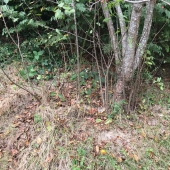I’ve got a relatively steep slope with various trees (poplar, prunus and black locust mostly..), a fair amount of joe pye and blackberry, and TONS of Japanese vining honeysuckle. The latter is doing a number on many of the smaller trees. Here I am in autumn (blue ridge mountains) and I am ripping it out, roots and all. It’s a tedious and lengthy endeavor, but some of this space I’d like to plant some fruit trees. I don’t need accesss to cultivate it all pet se, but if I were to leave it be, I’m a afraid the vines would destroy half the trees, or at least render their future products a much reduced quality..
So here’s where I’m confused. There is no doubt that the vine network must be reducing runoff to a fair degree. So while it may be good for the trees, it’s not going to be good for erosion. There are various downed trees and branches all over the slope. I will definitely be laying these on various contours to help the runoff to a degree. But since the vines have been shading out the ground between the trees, I will be left with a lot of now bare ground.
Should I just let nature do it’s thing and add more blackberry and other “weeds,” or would it be wise to introduce several shrub species? If so, any suggestions on what may be good? I can definitely propagate some comfrey here and there, but I’m still pretty new in terms of my familiarity with different permaculture species..
Thanks for any advice!!





